Documents: Go to download!
User Manual
- User Manual - (English)
- Spec sheet - (English)
- Assembly/installation instructions - (English)
- Getting to know your appliance
- Rinse aid
- Utensils
- Detergent
- Operating the appliance
- Cleaning and maintenance
- Fault, what to do?
- Installation and connection
Table of contents
User Manual Dishwasher
Getting to know your appliance
Control panel
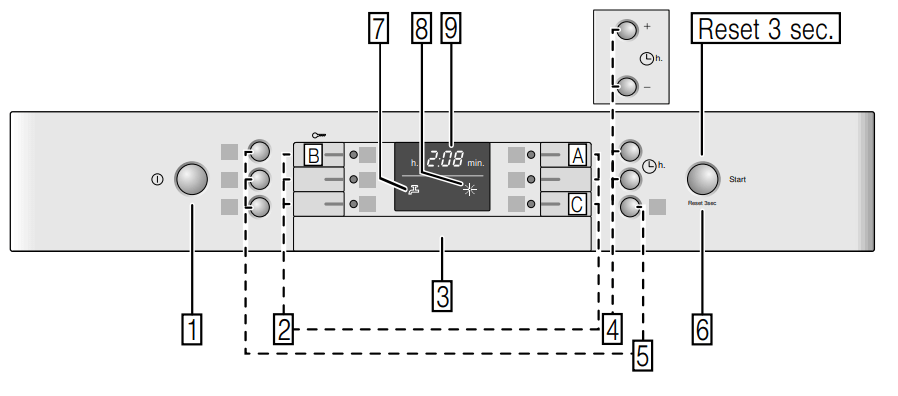
- ( On/off ) switch
- Programme buttons **
- Door opener
- Time preselection
- Additional functions/programme buttons **
- START button
- Display "Check water supply"
- Rinse aid refill indicator
- Display window
* depending on the features of your dishwasher
** number depending on the features of your dishwasher
Appliance interior
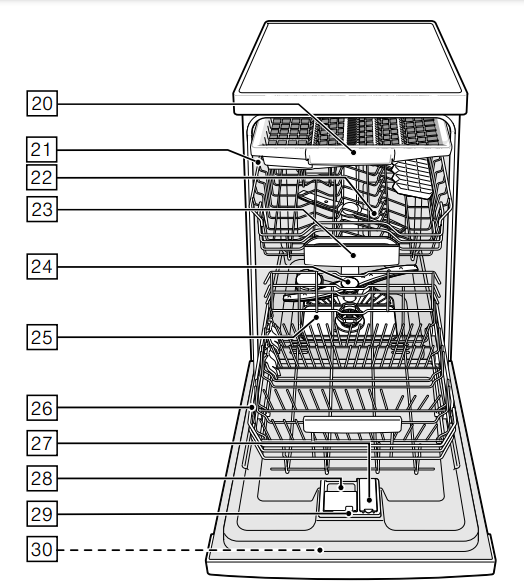
20. Cutlery drawer
21. Top basket
22. Upper spray arm
23. Tablet collecting tray
24. Bottom spray arm
25. Filters
26. Bottom basket
27. Dispenser for rinse aid
28. Detergent dispenser
29. Lock for detergent dispenser
30. Rating plate
* depending on model
Overview of menu
The settings can be found in the individual chapters.
 Intensive drying
Intensive drying
 Rinse aid
Rinse aid
 Automatic disconnection
Automatic disconnection
 Hot water
Hot water *
*
* depending on model
Rinse aid
As soon as the rinse-aid refill indicator  is lit on the fascia, there is still a rinse-aid reserve of 1-2 rinsing processes. Refill with rinse aid. The rinse aid is required for stain-free utensils and clear glasses. Use only rinse aid for domestic dishwashers.
is lit on the fascia, there is still a rinse-aid reserve of 1-2 rinsing processes. Refill with rinse aid. The rinse aid is required for stain-free utensils and clear glasses. Use only rinse aid for domestic dishwashers.
Combined detergents with rinse-aid component may be used up to a water hardness of 21° dH (37° fH, 26° Clarke, 3.7 mmol/l) only. If the water hardness is over 21° dH, rinse aid must be used.
1. Open the dispenser  by pressing and lifting the plate on the cover.
by pressing and lifting the plate on the cover.
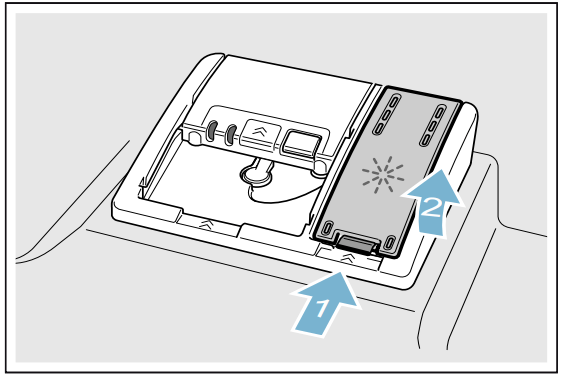
2. Carefully pour rinse aid up to the max. mark in the filler opening.
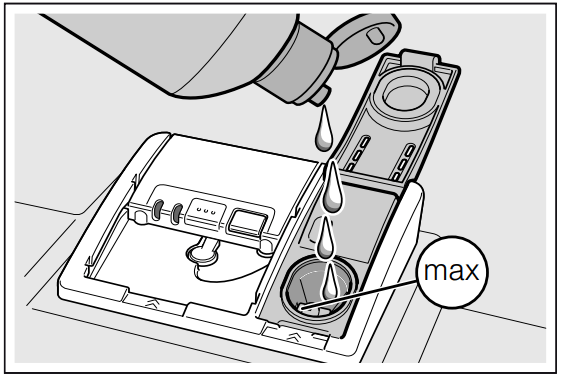
3. Close cover until it clicks shut.
4. To prevent excessive foam formation during the next rinse cycle, remove any rinse aid which has run over with a cloth.
Setting amount of rinse aid
The amount of rinse aid can be set from  and
and  . Please set rinse aid on
. Please set rinse aid on  to obtain very good drying results (
to obtain very good drying results ( is already set in factory).
is already set in factory).
Do not change the amount of rinse aid unless streaks (select lower setting) or water stains (select higher setting) are left on the utensils.
1. Close the door
2. Switch on ON/OFF switch  .
.
3. Hold down the programme button  and press START button
and press START button  until
until  ... is indicated on the digital display.
... is indicated on the digital display.
4. Release both buttons.
5. Press the programme button until the factory set value
until the factory set value  is indicated on the digital display
is indicated on the digital display  .
.
To change the setting:
1. Press programme button  . Each time the button is pressed, the set value increases by one level; when the value of
. Each time the button is pressed, the set value increases by one level; when the value of  has been reached, the display jumps back to
has been reached, the display jumps back to  (off)
(off)
2. Press START button  . The set value is saved.
. The set value is saved.
Switching off rinse aid refill indicator
If the rinse aid refill indicator  bothers you (e.g. if you are using a combination detergent with a rinse aid component), you can switch off the rinse aid refill indicator.
bothers you (e.g. if you are using a combination detergent with a rinse aid component), you can switch off the rinse aid refill indicator.
Proceed as described under “Setting amount of rinse aid” and set the value to .
.
The rinse aid refill indicator  is now switched off.
is now switched off.
Utensils
Not suitable
- Cutlery and utensils made of wood.
- Delicate decorative glasses, craft, and antique utensils. These decors are not dishwasher-proof.
- Plastic parts not resistant to heat.
- Copper and tin utensils.
- Utensils which are soiled with ash, wax, lubricating grease or ink.
Aluminum and silver parts have a tendency to discolor and fade during the wash cycle. Even some types of glass (e.g. crystal glass objects) may turn cloudy after many wash cycles.
Glass and utensil damage
Causes:
■ Glass type and glass production process.
■ Chemical composition of the detergent.
■ Water temperature of the wash programme.
Recommendation:
■ Use only glasses and porcelain which the manufacturer designates as dishwasher-proof.
■ Use a detergent which protects utensils.
■ Take glass and cutlery out of the dishwasher as soon as possible after the programme ends.
Loading the dishwasher
1. Remove large food remnants. It is not necessary to prerinse utensils under running water.
2. Place the utensils so that
– they are secure and cannot tip over.
– all utensils with their openings face down.
– parts with curves or indentations are at an angle, thereby allowing water to drain.
– does not obstruct rotation of the two spray arms  and
and 
Very small utensils should not be washed in the machine, as they may fall out of the baskets.
Unloading the dishwasher
To prevent water from dripping off the upper basket onto the utensils in the lower basket, it is recommended to empty the appliance from the bottom up.
Hot utensils are sensitive to shock! Therefore, when the programme ends, leave the utensils to cool down in the dishwasher until they can be handled.
Cups and glasses
Top basket 

Note: Utensils must not be placed above the tablet collecting tray  . These may block the lid of the detergent dispenser and prevent it from opening fully.
. These may block the lid of the detergent dispenser and prevent it from opening fully.
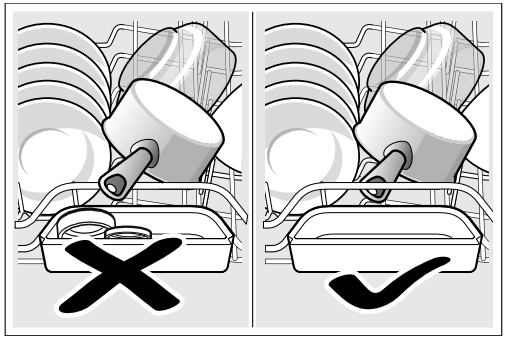
Pans
Bottom basket 
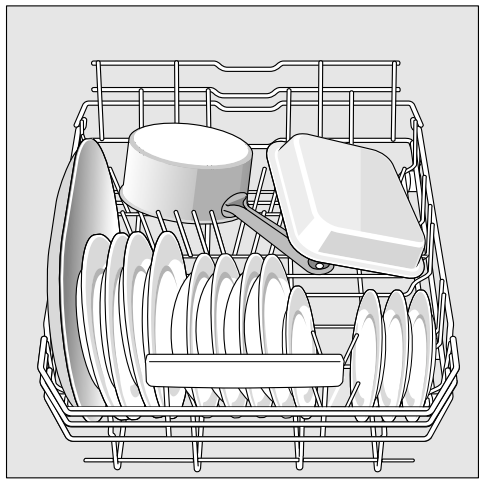
Tip- Heavily soiled utensils (pans) should be placed in the bottom basket. The more powerful spray jet provides a better dishwashing result.
Other examples, such as the best way of loading your dishwasher, can be found on our homepage as a free download. The corresponding Internet address can be found on the back page of these instructions for use.
Cutlery drawer
Arrange the cutlery in the cutlery drawer  as illustrated. Separately arranged cutlery is easier to remove after washing.
as illustrated. Separately arranged cutlery is easier to remove after washing.
The drawer can be taken out

Folding spikes *
* depending on model
The spikes can be folded down to improve arrangement of pans, bowls and glasses

Small accessories holder *
* depending on model
Light-weight plastic accessories, e.g. cups, lids, etc. can be held securely in the small accessories holder.
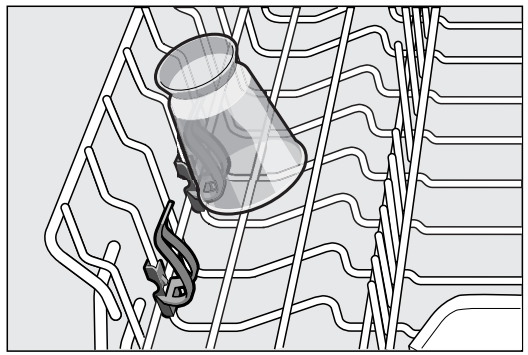
Adjusting the height of the basket
The height of the upper utensils basket  can be adjusted in 3 stages to create more space either in the upper or lower basket.
can be adjusted in 3 stages to create more space either in the upper or lower basket.
Appliance height 81.5 cm
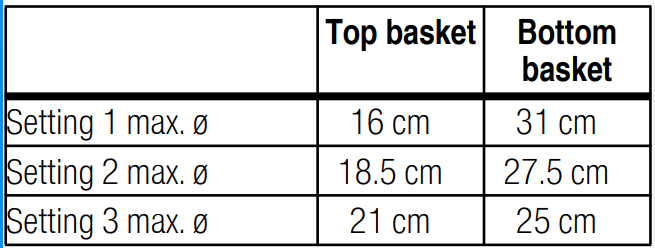
1. Pull out the top basket  out.
out.
2. To lower the basket, press in the left and then the right lever on the outside of the basket. In doing so, hold the sides of the basket along the upper edge to prevent it from suddenly dropping.
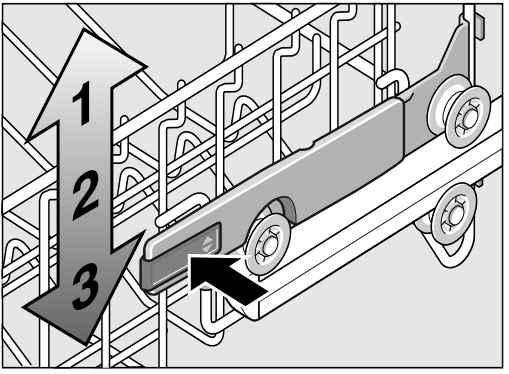
3. To raise the basket, hold the basket on the sides of the upper edge and lift it up.
4. Before re-inserting the basket again, ensure that it is at the same height on both sides. Otherwise, the appliance door cannot be closed and the upper spray arm will not be connected to the water circuit.
Detergent
You can use tablets as well as powder or liquid detergents for dishwashers, but never use washing-up liquid. The dosage can be individually adjusted with powder or a liquid detergent according to the degree of soiling. Tablets contain an adequately large amount of active ingredients for all cleaning tasks. Modern, powerful detergents predominantly use a low-alkaline formulation with enzymes. Enzymes break down starch and remove protein. To remove colored stains (e.g. tea, ketchup), oxygen-based bleaching agents are generally used.
Note: To ensure a good washing result, always follow the instructions on the detergent packaging! If you have further questions, we recommend that you contact the detergent manufacturers’ helplines.
Adding detergent
1. If the detergent dispenser is still closed, press the lock
is still closed, press the lock  to open the detergent dispenser.
to open the detergent dispenser.
Pour detergent into the dry detergent dispenser  only (insert tablet flat, not on its edge).
only (insert tablet flat, not on its edge).
Dosage: see manufacturer’s instructions on the packaging.
The graduated detergent dispenser  helps you add the correct amount of powder or liquid detergent
helps you add the correct amount of powder or liquid detergent
Usually, 20 ml–25 ml are adequate for normal soiling. If using tablets, one tablet is adequate.
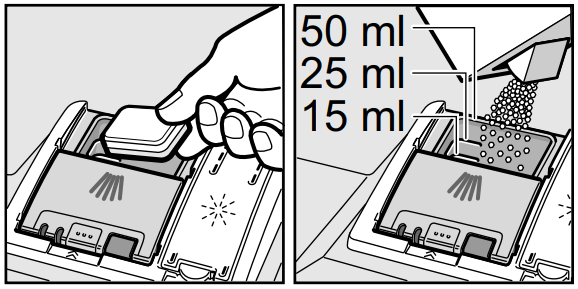
2. Close the cover on the detergent dispenser by sliding it up until the lock engages without difficulty
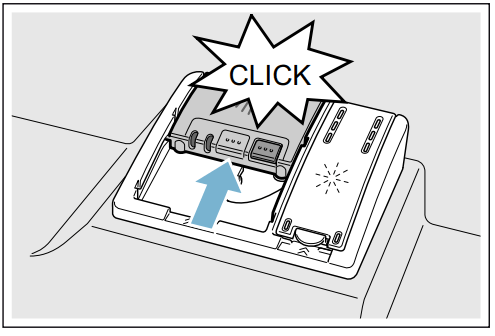
The detergent dispenser opens automatically at the optimum time depending on the programme. The powder or liquid detergent is distributed in the appliance and is dissolved, the tablet falls into the tablet collecting tray where it dissolves in doses.
Tip: If the utensils are only lightly soiled, slightly less than the indicated amount of detergent is usually adequate. Suitable detergents and care products can be purchased online via our website or via customer service (see back page).
Operating the appliance
AquaSensor *
* depending on the features of your dishwasher
The Aqua sensor is an optical measuring device (light barrier) which measures the turbidity of the rinsing water.
The AquaSensor is used according to the programme. If the AquaSensor is active, “clean” rinsing water can be transferred to the next rinse bath and water consumption can be reduced by 3–6 litres. If the turbidity is greater, the water is drained and is replaced with fresh water. In the automatic programmes the temperature and running time can also be adjusted to the degree of soiling.
Switching on the appliance
1. Turn tap fully on.
2. Switch on ON/OFF switch . The display of the last selected programme flashes. This programme remains selected if no other programme button
. The display of the last selected programme flashes. This programme remains selected if no other programme button is pressed. The expected programme duration flashes on the digital display
is pressed. The expected programme duration flashes on the digital display
3. Press the START button  . The programme starts running.
. The programme starts running.
Remaining running time display
When the programme is selected, the remaining running time of the programme is indicated on the digital display .
.
The running time is determined during the programme by the water temperature, the quantity of dishes as well as the degree of soiling and may vary (depending on the selected programme).
Time preselection *
* depending on the configuration of your specific dishwasher You can delay the start of the programme in hourly steps by up to 24 hours.
1. Close the door.
2. Switch on ON/OFF switch  .
.
3. Press the timer programming button  + until the digital display
+ until the digital display jumps to
jumps to 
4. Press  - or + button until the displayed time corresponds with your requirements.
- or + button until the displayed time corresponds with your requirements.
5. Press START button  .timer programming is activated.
.timer programming is activated.
6. . To delete timer programming, press the - or + button until
- or + button until
 is indicated on the digital display. You can change your programme selection at any time until the programme starts.
is indicated on the digital display. You can change your programme selection at any time until the programme starts.
End of programme
The programme has ended when the value  appears in the display window
appears in the display window  .
.
Switching off automatically after the end of the programme *S
* depending on model
To save energy, the dishwasher is switched off 1 minute after the programme ends (factory setting).
Automatic disconnection can be adjusted from  to
to 
 Appliance does not switch off automatically
Appliance does not switch off automatically
 Off after 1 min
Off after 1 min
 Off after 120 min
Off after 120 min
1. Close the door.
2. Switch off ON/OFF switch  .
.
3. Hold down programme button  and press START button
and press START button  until
until  ... is indicated on the digital display
... is indicated on the digital display
4. Release both buttons.
5. Press programme button  until the factory set value
until the factory set value  is indicated on the digital display
is indicated on the digital display 
To change the setting:
1. Press programme button  . Each time the button is pressed, the set value increases by one level; when the value of
. Each time the button is pressed, the set value increases by one level; when the value of  has been reached, the display jumps back to
has been reached, the display jumps back to (off).
(off).
2. Press START button . The set value is saved.
. The set value is saved.
Switching off the appliance
Short time after the end of the programme:
1. Switch off ON/OFF switch
2. Turn off the tap (not applicable if Aqua-Stop fitted).
3. Open the door.
4. Remove the utensils when they have cooled down
Interrupting the programme
1. Switch off ON/OFF switch  . The LEDs go out. The programme is saved. If the door was opened on an appliance which has a warm water connection or is heated, first leave the door ajar for several minutes and then close. Otherwise, expansion (pressure) may cause the appliance door to spring open or water to run out of the appliance.
. The LEDs go out. The programme is saved. If the door was opened on an appliance which has a warm water connection or is heated, first leave the door ajar for several minutes and then close. Otherwise, expansion (pressure) may cause the appliance door to spring open or water to run out of the appliance.
2. To continue the programme, switch on the ON/OFF switch  again.
again.
Terminating the programme (Reset)
1. Press the START button  P for approx. 3 sec. The numerical display
P for approx. 3 sec. The numerical display indicates
indicates
2. The programme sequence lasts approx. 1 min. On the digital display  is indicated
is indicated  .
.
3. Switch off ON/OFF switch  .
.
Changing the programme
When the START button  hhas been pressed, the programme cannot be changed.
hhas been pressed, the programme cannot be changed.
The only way a programme can be changed is by Cancel programme (Reset).
Intensive drying
The final rinse uses a higher temperature which improves the drying result. The running time may increase slightly. (Caution if utensils are delicate!)
1. Close the door.
2. Switch on ON/OFF switch 
3. Hold down the programme button  and press START button
and press START button  until the digital display
until the digital display  .
. ... is indicated.
... is indicated.
4. Release both buttons.
To change the setting:
1. Press the button  to switch the Intensive drying on
to switch the Intensive drying on or off
or off 
2. Press START button  . The set value is saved.
. The set value is saved.
Cleaning and maintenance
Overall condition of the machine
■ Check spray arm for grease and limescale deposits.
If you find such deposits:
■ Fill detergent dispenser with detergent. Start the appliance without utensils in the programme with the highest rinsing temperature.
Clean the appliance with detergents/ appliance cleaners which are particularly suitable for use with dishwashers.
■ To extend the life of your appliance, clean the appliance regularly with a special dishwasher detergent.
■ To ensure that the door seal always remains clean and hygienic, regularly clean it with a damp cloth and a little washing-up liquid.
■ If the appliance is switched off for a prolonged period, leave the door ajar to prevent the formation of an unpleasant odour.
Never use a steam cleaner to clean your dishwasher. The manufacturer is not liable for any consequential damage. Regularly wipe the front of the appliance and fascia with a damp cloth; water and a little washing up liquid are adequate. Do not use sponges with a rough surface or abrasive detergents, as these could scratch the surfaces.
Stainless steel appliances: To prevent corrosion, avoid using sponge cloths or wash them out thoroughly several times before using for the first time.
Rinse aid
Check the refill indicator If required, refill rinse aid.
If required, refill rinse aid.
Filters
The filters  keep large foreign objects in the rinsing water away from the pump. these foreign objects may occasionally block the filters.
keep large foreign objects in the rinsing water away from the pump. these foreign objects may occasionally block the filters.
The filter system consists of a coarse filter, a flat fine filter and a microfilter.
1. After each washing cycle check the filters for residue.
2. Unscrew filter cylinder as illustrated and take out filter system.


3. Remove any residue and clean filters under running water.
4. Re-install filter system in reverse sequence and ensure that the arrow marks are opposite each other after closing the filter system.
Spray arms
Limescale and contaminants in the rinsing water may block nozzles and bearings on the spray arms  and
and  .
.
1. Check outlet nozzles on the spray arms for blockages.
2. Unscrew the upper spray arm  (1/4 revolution).
(1/4 revolution).
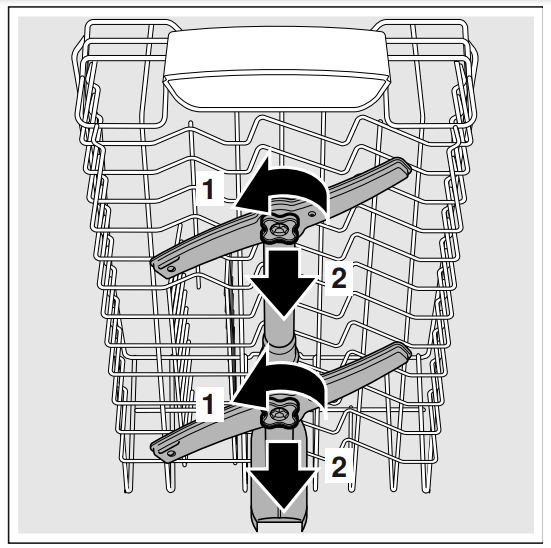
3. Remove the lower spray arm  upwards.
upwards.
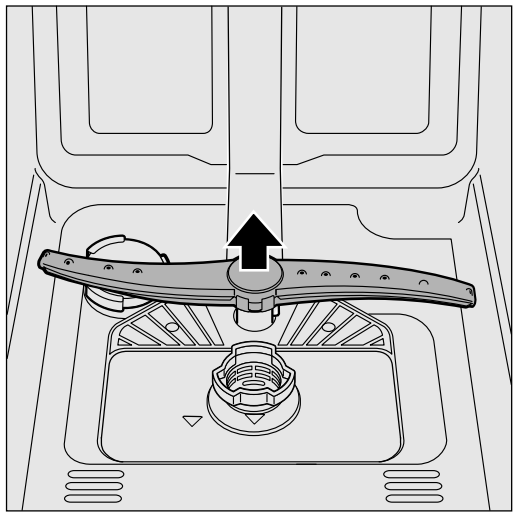
4. Clean spray arms under running water.
5. Re-engage or screw on spray arms.
Fault, what to do?
Experience has shown that you can rectify most faults which occur in daily operations yourself. This ensures that the appliance is quickly available to you again. In the following overview you can find possible causes of malfunctions and helpful information for rectifying them.
Note: If the appliance stops during dishwashing or does not start for no obvious reason, first run the Abort programme function (Reset) → "Operating the appliance" on page 25.
Waste water pump
Large food remnants or foreign objects which were not captured by the filters may block the waste water pump. The rinsing water will then be above the filter.
When cleaning the waste water pump, ensure that you do not injure yourself on pieces of broken glass or pointed implements.
In this case:
1. . First always disconnect the appliance from the power supply
2. Take out top basket  and bottom basket
and bottom basket .
.
3. Remove the filters  .
.
4. Scoop out water, use a sponge if required.
5. Prise off the pump cover (as shown) using a spoon. Grip the pump cover by the crosspiece and lift diagonally inwards (1). Remove cover completely.
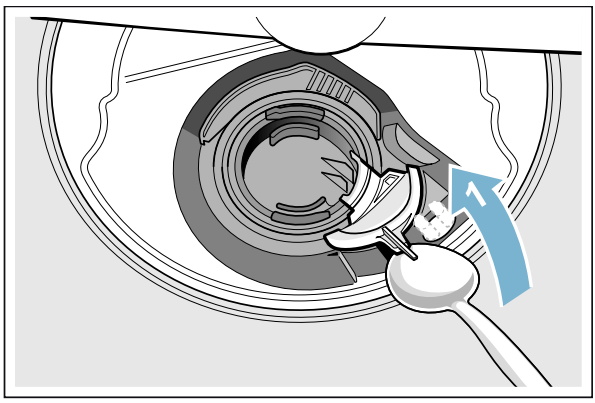
6. Check impeller wheel and remove any foreign objects.
7. Place cover in the original position and press down until it engages (click).
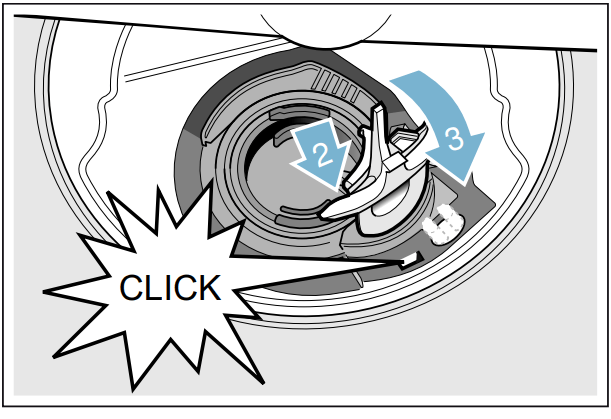
8. Install filters.
9. Re-insert baskets.
Fault table
Fault | Reason | Solution |
“Check water supply” display  lights up lights up | Supply hose kinked | Install supply hose without kinks |
| Tap turned off | Turn on the tap | |
| Tap jammed or calcified. | Turn on the tap. Flow rate must be at least 10 l/min. when water supply is open. | |
| Filter in the water supply blocked. | Switch off the appliance and pull out the main plug. Turn off the tap. Unscrew water connection. 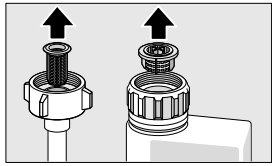 Clean filter in the supply hose. Screw water connection on again. Check for leaks. Reconnect power supply. Switch on the appliance. | |
Fault code  is lit. is lit. | Intake opening (on right inside of appliance) covered by utensils. | Arrange utensils so that the intake opening is not obstructed. |
Fault code  is lit. is lit. | Heating element soiled. | Clean appliance with dishwasher cleaning agent. |
Fault code  is lit. is lit. | Water protection active. | Turn off tap. Call customer service and quote the fault code. |
Fault code  is lit. is lit. | ||
Fault code  is lit. is lit. | Constant water supply. | |
Fault code  is lit. is lit. | Filters  are soiled or blocked. are soiled or blocked. | Clean filters.→ "Filters" on page 29 |
Fault code  is lit. is lit. | Wastewater hose kinked or blocked. | Install hose without kinks, remove any residue. |
| Siphon connection still sealed | Check connection to siphon and open if required. | |
| Cover on the wastewater pump loose. | Lock cover correctly.Lock cover correctly.→ "Waste water pump" on page 31 | |
Fault code is lit. is lit. | Wastewater pump blocked or cover on the wastewater pump is not locked in position. | Clean pump and lock cover correctly. → "Waste water pump" on page 31 |
Fault code  is lit. is lit. | Mains voltage too low. | No appliance fault, have the mains voltage and electrical installation checked. |
A different fault code is indicated on the digital display.  to to ) ) | A technical fault has probably occurred. | Switch off the appliance with the ON/OFF switch  .After a short time, restart the appliance. If the problem recurs, turn off the tap and pull out the mains plug. Call customer service and mention the fault code. .After a short time, restart the appliance. If the problem recurs, turn off the tap and pull out the mains plug. Call customer service and mention the fault code. |
| Display flashes | Not a fault! | See TurboSpeed 20 min. in the chapter “Overview of programmes”. * |
Refill indicator for rinse aid is lit. is lit. | No rinse aid. | Refill rinse aid. |
Refill indicator for rinse aid is not lit. is not lit. | Refill indicator switched off. | Activation/deactivation (see chapter Rinse aid). |
| There is still enough special rinse aid available. | Check refill indicator, level | |
| Water is left in the appliance at the end of the programme. | Filter system or area under the filters  is blocked. is blocked. | Clean filters and area underneath (see “Waste water pump”). |
| The programme has not yet ended | Wait until programme ends or reset (see “Terminating the programme”). | |
| Utensils not dry. | Wait until programme ends or reset (see Terminating the programme). | Refill rinse aid. |
| Programme selected without drying.. | Select programme with drying (see Overview of programmes, Programme sequence). | |
| Water collecting in depressions on the utensils and cutlery | Arrange utensils in a sloping position, arrange affected utensils as sloping as possible.  | |
| The combined detergent used has a poor drying performance | Use different combination detergent with better drying performance. Use of rinse aid also improves the drying performance. | |
| Intensive drying to increase drying not activated. | Activate intensive drying (see Operating the appliance) | |
| Utensils were removed too early or drying process had not ended yet. | Wait until the programme ends, or wait until 30 minutes after the end of the programme before removing the utensils. | |
| The eco-rinse aid used has a poor drying performance. | Use a name-brand rinse aid. Eco products are much less effective. | |
| Plastic utensils not dry. | Special properties of plastic. | Plastic has a lower heat storage capacity and therefore dries less well. |
| Cutlery not dry. | Cutlery not arranged properly in the cutlery basket. | Separate cutlery if possible, prevent contact points. |
| Cutlery not arranged properly in the cutlery drawer. | Arrange cutlery properly and separate if possible. | |
| Appliance interior wet after rinse cycle. | No appliance fault. | On account of the “Condensation drying” principle, water droplets are physically induced and required in the container.The humidity in the air condenses on the inner walls of the dishwasher, drains and is pumped out. |
| Food remnants on the utensils. | Utensils placed too closely together, utensils basket overfilled. | Arrange utensils with adequate clearance between them ensuring that the spray jets can reach the surface of the utensils. Prevent contact points. |
| Spray arm rotation obstructed. | Arrange utensils so that the spray arm can rotate without obstruction. | |
| Spray arm nozzles are blocked. | Clean the spray arm nozzles, (See Cleaning and maintenance). | |
Filters dirty. dirty. | Clean filters, (see Cleaning and maintenance). | |
Filters  inserted incorrectly and/or not engaged. inserted incorrectly and/or not engaged. | Insert and engage filters correctly. | |
| Rinse programme too weak. | Select a more intensive rinse programme. | |
| Utensils precleaned too intensely; sensors therefore decide on weak programme sequence. Stubborn soiling cannot be completely removed. | Do not prerinse utensils.Remove only large food remnants. | |
| Tall narrow receptacles in corner areas are not rinsed adequately | Do not place tall narrow receptacles too obliquely and do not place in the corner area | |
Top basket  on right and left not set to same height. on right and left not set to same height. | Set top basket to same height using side levers. | |
| Detergent residue | Detergent dispenser cover blocked by utensils and therefore does not open fully | Detergent dispenser cover must not be obstructed by utensils. Do not place utensils or fragrance dispenser in the tablet collecting tray. |
| Detergent dispenser cover blocked by the tablet. | Tablet must be inserted flat and not upright. | |
| Tablets used in the quick or short programme. Dissolving time of the detergent is not reached in the selected short programme. | Dissolving time of tablets too long for a quick or short programme. Use a detergent powder or select a more intensive programme. | |
| Washing effect and dissolving performance are reduced after a prolonged storage time or detergent is very lumpy | Change detergent. | |
| Water stains on plastic parts. | Droplet formation on plastic surface is physically unavoidable. After drying, water stains are visible. | Use a more intensive programme (more water changes). Arrange utensils in a sloping position. Use rinse aid. |
| Washable or water-soluble coatings in the container or on the door. | Detergent substances are deposited. These coatings cannot usually be removed with chemicals (appliance cleaner, ...). | Change detergent brand. Clean appliance mechanically. |
| Only for glasses: Initial glass corrosion – can only apparently be wiped off. | See “Glass and utensil damage” | |
| White, stubborn coatings; limescale on the utensils, container or door. | Detergent substances are deposited. These coatings cannot usually be removed with chemicals (appliance cleaner, ...) | Change detergent brand. Clean appliance mechanically |
| Underdosing of detergent. | Increase detergent dosage or change detergent. | |
| Too weak rinse programme selected. | Select a more intensive rinse programme. | |
| Tea or lipstick residue on the utensils. | Too low rinsing temperature. | Select programme with higher rinsing temperature. |
| Too little or unsuitable detergent. | Use suitable detergent at correct dosage. | |
| Utensils precleaned too intensely; sensors therefore decide on weak programme sequence. Stubborn soiling cannot be completely removed. | Do not prerinse utensils.Remove only large food remnants. | |
| Coloured (blue, yellow, brown), difficult to remove to non-removable coatings in the appliance or on stainless steel utensils. | Film formation consisting of ingredients from vegetables (e.g. cabbage, celery, potatoes, noodles, ...) or the tap water (e.g. manganese). | Can be partly removed with machine cleaner or by mechanical cleaning. Coatings are harmless. |
| Film formation caused by metallic components on silver or aluminium utensils. | Can be partly removed with machine cleaner or by mechanical cleaning. | |
| Discolouration of the plastic parts inside the appliance. | Plastic parts inside the appliance may become discoloured during the service life of the dishwasher. | Discolouration is normal and will not impair the function of the dishwasher |
| Plastic parts discoloured. | Too low rinsing temperature. | Select programme with higher rinsing temperature. |
| Utensils precleaned too intensely; sensors therefore decide on weak programme sequence. Stubborn soiling cannot be completely removed. | Do not prerinse utensils.Remove only large food remnants. | |
| Removable streaks on glasses, glasses with metallic appearance and cutlery. | Too much rinse aid. | Set rinse aid amount to lower setting setting. |
| No rinse aid added or setting too low | Add rinse aid and check dosage (recommended Level 4–5). | |
| Detergent residue in the final rinse. Detergent dispenser cover blocked by utensils (cover does not open fully). | Detergent dispenser cover must not be obstructed by utensils. Do not place utensils or fragrance dispenser in the tablet collecting tray. | |
| Utensils precleaned too intensely; sensors therefore decide on weak programme sequence. Stubborn soiling cannot be completely removed. | Do not prerinse utensils.Remove only large food remnants. | |
| Initial or existing, irreversible clouding of glass. | Glasses not dishwasher-proof, only suitable for dishwasher. | Use dishwasher-proof glasses. Avoid long steam phase (standing time after rinse cycle ends). Use rinse cycle at lower temperature. Use detergent with glass protection component. |
| Rust spots on the cutlery. | Cutlery is not sufficiently rust-resistant.Knife blades are frequently more severely affected. | Use rust-resistant cutlery. |
| Cutlery will also rust if rusting parts are rinsed at the same time (pan handles, damaged utensil baskets, etc.). | Do not wash rusting parts. | |
| Appliance cannot be switched on or operated. | Malfunction. | Disconnect appliance from the power supply; pull out the mains plug or switch off the fuse. Wait at least 5 seconds, then connect the appliance to the power supply. |
| The appliance does not start. | The mains fuse has tripped. | Check mains fuse. |
| Power cord not inserted. | Ensure that the power cord is plugged all the way into the back of the appliance and into the socket. Check that the socket functions. | |
| The appliance door has not been shut properly. | Close the door. | |
| Programme starts automatically. | You did not wait until programme ended. | Perform reset. (See “Terminating the programme”) |
| The door is difficult to open. | Child-proof lock is activated. | Deactivate child-proof lock.(See instructions for use at the back) |
| Door cannot be closed. | Door lock has been activated. | Close door with increased force. |
| Door cannot be closed due to installation. | Check appliance installation: Door or attached parts must close without obstruction. | |
| Cover on the detergent dispenser cannot be closed. | Detergent dispenser or cover guide blocked by sticky detergent residue | Remove detergent residue. |
| Detergent residue in the detergent dispenser or in the tablet collecting tray | Spray arms blocked by utensils, therefore detergent is not rinsed out. | Ensure that the spray arms can rotate freely. |
| The detergent dispenser was damp when filled. | Pour detergent into the dry detergent dispenser only. | |
| Appliance stops during the programme or programme is interrupted. | Door not closed properly. | Close the door. |
| Do not place utensils or fragrance dispenser in the tablet collecting tray. Top basket presses against the door and prevents door from being closed securely. | Check whether rear panel is being pressed in, e.g. by socket or by hose holder which has not been removed. | |
| Power and/or water supply interrupted. | Restore power and/or water supply | |
| Filling valves making striking noises. | Depends on domestic installation, as appliance is not defective. No effect on appliance function. | No remedial action possible. |
| Knocking or rattling noise. | Spray arm strikes the utensils, utensils not positioned correctly | Position utensils so that the spray arms do not strike the utensils. |
| If there is a low load, the water jets strike the washing tank directly. | Load the appliance with more utensils or distribute the utensils more evenly in the dishwasher. | |
| Light utensils move during the rinse cycle. | Arrange light utensils securely. | |
| Unusual foam formation. | Hand washing-up liquid in the rinse aid dispenser. | Immediately refill rinse aid dispenser with rinse aid. |
| Rinse aid spilled. | Remove rinse aid with a cloth. |
Installation and connection
The dishwasher must be connected correctly, otherwise, it will not function properly. The specifications for the inlet and outlet as well as the electrical connected loads must correspond with the required criteria as specified in the following paragraphs or in the installation instructions. Install the appliance in the correct sequence:
1. Checking appliance on delivery
2. Installing the appliance
3. Waste water connection
4. Drinking water connection
5. Electrical connection
Product package
If you have any complaints, contact the dealer from whom you purchased the appliance or our customer services.
■ Dishwasher
■ Instructions for use
■ Installation instructions
■ Warranty*
■ Installation materials
■ Steam guard plate*
■ Rubber apron*
■ Power cord
* depending on model
Technical specifications
Weight: max. 45 kg
Voltage: 220–240 V, 50 Hz or 60 Hz
Connected load: 2000–2400 W
Fuse: 10/16 A (UK 13A)
Power input: switched off 0.10 W not switched off 0.10 W
Water pressure: at least 0.05 MPa (0.5 bar), maximum 1 MPa (10 bar). At a higher water pressure: connect pressure-reducing valve ahead.
Inlet rate: minimum 10 litres/minute
Water temperature: for cold water connection only.
Capacity: 9–11 place settings (depending on model).
Installation
The required installation dimensions can be found in the installation instructions. Level the appliance with the aid of the height-adjustable feet. Ensure that the appliance is situated securely on the floor.
■ A built-under or integrated appliance which is installed subsequently as a free-standing appliance must be secured to prevent it from overturning, e.g. by screwing it to the wall or by installing it under a continuous worktop which is screwed to adjacent cupboards.
■ The appliance can easily be installed in a fitted kitchen between wooden and plastic walls.
Waste-water connection
1. The required work sequence can be found in the installation instructions. If required, fit a siphon with an drainage connection.
2. Connect the waste-water hose to the drainage connection of the siphon with the enclosed parts. Ensure that the drainage hose is not kinked, crushed or twisted and that there is no cover plate in the drainage to prevent the waste water from flowing out!
Drinking water connection
1. Fasten the drinking water connection to the tap according to the installation instructions using the enclosed parts. Ensure that the drinking water connection is not kinked, crushed or twisted.
2. When replacing the appliance, always use a new water supply hose.
Water pressure:
at least 0.05 MPa (0.5 bar), maximum 1 MPa (10 bar). At a higher water pressure: connect pressure-reducing valve ahead.
Inlet rate:
minimum 10 litres/minute
Water temperature:
for cold water connection only.
Electrical connection
■ Connect the appliance to an alternating current only, ranging from 220 V to 240 V and 50 Hz or 60 Hz via a correctly installed socket with protective earth conductor. See rating plate for required fusing 9".
■ The socket must be near the appliance and freely accessible following installation. If the plug is not freely accessible, an allpole disconnector with a contact opening of at least 3 mm must be fitted on the installation side to satisfy the relevant safety instructions.
■ The connection may be modified by technicians only.
■ A power cord extension may be purchased from customer service only.
■ Use only a residual current operated circuit-breaker which features the symbol . Only this extension guarantees compliance with the currently valid regulations.
. Only this extension guarantees compliance with the currently valid regulations.
■ The appliance features a water damage protection system. Please note the system will not function unless the power supply is connected.
Removing the appliance
Also observe the sequence of worksteps here.
1. Disconnect the appliance from the power supply.
2. Turn off the water supply.
3. Undo the waste water and drinking water connection.
4. Loosen fastening screws for the furniture parts.
5. If fitted, remove the base panel.
6. Pull out the appliance, carefully pulling the hose behind.
Transportation
1. Turn on the tap.
2. Close the door
3. Switch on ON/OFF switch 
4. Select programme with the highest temperature. The expected programme duration is indicated on the numerical display
5. Press START button P. Programme sequence starts.
6. After approx. 4 minutes press the START button until
until  ‚ is indicated on the digital display. After approx. 1 min
‚ is indicated on the digital display. After approx. 1 min  is indicated on the digital display .
is indicated on the digital display .
7. Switch off ON/OFF switch
8. Turn off the tap, disconnect supply hose and drain water. Transport appliance upright only. (This prevents residual water from running into the machine control and damaging the programme sequence.)
Protection against frost
If the appliance is in a room where there is a risk of frost (e.g. holiday home), empty the appliance completely (see Transportation).
See other models: SMU50E75AU SMU46GS01A SMI46GS01A SMV46GX01A SMI50D05AU
